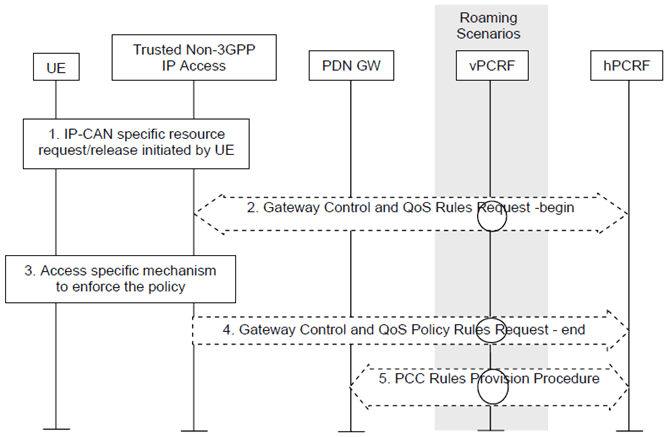Content for TS 23.402 Word version: 18.3.0
0…
4…
4.2…
4.2.2
4.2.3
4.3…
4.4…
4.5…
4.5.7…
4.6…
4.7…
4.7.2…
4.8…
4.8.2a…
4.9…
5…
5.2…
5.4…
5.5
5.6…
5.7…
5.8…
6…
6.2…
6.3
6.4…
6.4.3…
6.5…
6.6…
6.7…
6.8…
6.10…
6.13…
6.15…
7…
7.2…
7.3
7.4…
7.5…
7.6…
7.8…
7.10…
8…
8.2.1.2
8.2.1.3…
8.2.2
8.2.3…
8.2.6…
8.3…
8.4…
8.5…
9…
9.3…
9.4…
10…
13…
16…
16.1.2…
16.1.6…
16.2…
16.2.1a…
16.3…
16.4…
16.7…
16.8…
16.10…
17…
A…
C…
E…
6.7 UE-initiated Resource Request and Release
6.7.1 UE-initiated Resource Request and Release on S2a
6.7.2 UE-initiated Resource Request for S2c over Trusted Non-3GPP IP Access
...
...
6.7 UE-initiated Resource Request and Release p. 141
6.7.1 UE-initiated Resource Request and Release on S2a p. 141
This procedure is applicable to both PMIPv6 on S2a and DSMIPv6 on S2c.
This clause is related to the case when UE-initiated resource request and release is supported in the Trusted Non-3GPP IP Access, and it is utilized for the S2a/S2c traffic flow aggregates.
Figure 6.7.1-1 depicts the procedure for the roaming and non-roaming cases.

Figure 6.7.1-1: UE-initiated resource request/release with S2a or S2c
(⇒ copy of original 3GPP image)
(⇒ copy of original 3GPP image)
The optional interaction steps between the gateways and the PCRF in the procedures only occur if dynamic policy provisioning is deployed. Otherwise policy may be statically configured with the gateway.
Both the roaming (Figure 4.2.3-1) and non-roaming (Figure 4.2.2-1) scenarios are depicted in the Figure. In the roaming case, the vPCRF acts as an intermediary, sending the QoS Policy Rules Provision from the hPCRF in the HPLMN to the trusted non-3GPP IP access in the VPLMN. The vPCRF receives the Acknowledgment from the trusted non-3GPP IP access and forwards it to the hPCRF. In the non-roaming case, the vPCRF is not involved at all.
Step 1.
Step 2 may be omitted if the Trusted non-3GPP IP access has already received authorisation for the UE's request from the PCRF, e.g. QoS rules downloaded at handover.
The trusted non-3GPP IP access receives an IP-CAN specific resource allocation or resource release request initiated by the UE.
Step 2.
The trusted non-3GPP IP access initiates the Gateway Control and QoS Policy Rules Request Procedure as specified in TS 23.203. The trusted non-3GPP IP access provides the UE request or release of resources as an Event Report. The PCRF makes a PCC decision as a result of the Gateway Control and QoS policy request and provides the updated QoS Rules to the trusted non-3GPP IP access.
Step 3.
An IP-CAN specific resource allocation or resource release procedure may be triggered by the enforcement of the received policy rules. In this step, a response for the resource request/release is sent to the UE.
Step 4.
The trusted non-3GPP IP access indicates to the PCRF whether the requested QoS Policy Rules Provision could be enforced or not and thus completing the GW Control and QoS Rules Provision procedure.
Step 5.
The PCRF initiates the Policy and Charging Rules Provision Procedure as specified in TS 23.203 to update the PCC rules in the PDN-GW. The updated PCC Rules and Event Triggers include any adjustments to resources due to the decision taken in step 2.
6.7.2 UE-initiated Resource Request for S2c over Trusted Non-3GPP IP Access p. 142
The procedure is specified in clause 6.7.1.